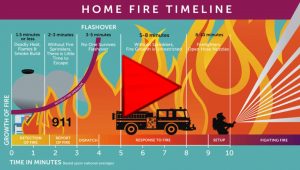Did you know that each sprinkler head activates independently in a home sprinkler system? A survey found that in most home fires, a single sprinkler could stop the spread of the fire! Here are more facts on sprinklers:
you know that each sprinkler head activates independently in a home sprinkler system? A survey found that in most home fires, a single sprinkler could stop the spread of the fire! Here are more facts on sprinklers:
- Challenges to Adoption. Since 2009, the installation of fire sprinklers has been required for new construction of homes by all U.S. model building codes. Many states and hundreds of U.S. communities have adopted this requirement. However, challenges to adoption exist in many other states including Texas. In fact, many builders in Texas still don’t even list sprinklers as a possible upgrade when purchasing a new construction home!
- Installation is Not Expensive. Modern home fire sprinklers are not expensive to have installed. The national average is just $1.35 per sprinklered square foot. For a fraction of the cost of natural stone counter-tops, you could save nearly your entire home from fire … in addition to saving the lives of your family, pets, and guests.
- Sprinkler Heads can be Covered. Sprinkler covers can be used to beautify and conceal sprinklers. With covers, you will hardly notice the sprinklers.
- Piping is Hidden. Fire sprinklers are usually supplied by the household water main. A tank and pump can be used where needed. They can be used in any climate. As with other plumbing, the piping is hidden behind walls and ceilings.
- Lives and Property are Saved. Fire sprinklers reduce the risk of dying in a home fire by 80 percent, and reduce the risk of property damage by 70 percent. Home fire sprinklers give residents more time to escape a fire safely. The sprinkler controls fire damage and confines it. That protects lives as well as surrounding rooms, limiting property damage. Because the sprinkler responds to the fire automatically and while it is still small, it controls the fire until the fire department arrives, slowing the spread of heat and poisonous smoke.
- False Alarms are Not an Issue. Sprinklers are activated by the high temperature of a fire – typically between 135 to 165°F. Cooking fumes or signaling smoke alarms cannot activate sprinklers.
- Water Flow is Relatively Low. Home fire sprinklers are designed to flow between 10-25 gallons of water per minute, which is a fraction (10 to 15 times LESS) of the water flow that Fire Department hoses use … and with far less pressure.
 Facts provided by the National Fire Protection Association (NFPA)
Facts provided by the National Fire Protection Association (NFPA)
Home Fire Sprinkler Coalition
PSA from the Texas State Fire Marshal’s Office
 you know that each sprinkler head activates independently in a home sprinkler system? A survey found that in most home fires, a single sprinkler could stop the spread of the fire! Here are more facts on sprinklers:
you know that each sprinkler head activates independently in a home sprinkler system? A survey found that in most home fires, a single sprinkler could stop the spread of the fire! Here are more facts on sprinklers: